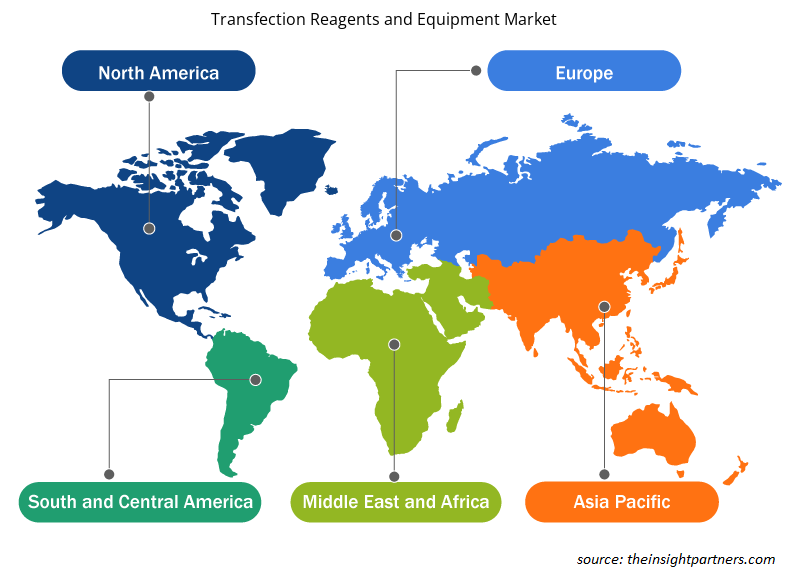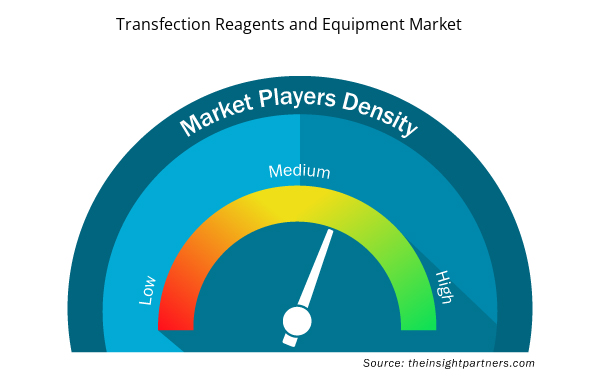[研究报告] 转染试剂和设备市场预计将从 2022 年的 11.7079 亿美元增长到 2030 年的 21.4503 亿美元;预计 2022 年至 2030 年的复合年增长率为 7.8%。
市场洞察和分析师观点:
转染试剂和设备市场规模的扩大归因于慢性病病例的增加以及细胞和基因治疗的日益普及。转染是通过化学、物理和生物手段将外来颗粒和核酸转移到细胞中的过程。转染试剂用于提高遗传实验的有效性,该实验是应用基因治疗领域进行的大量研究的一部分。在所有转染实验中,必须谨慎选择将化合物输送到细胞中的方法。病毒介导的转染已显示出相当大的有效性,转染产物可以诱导显着的免疫反应。然而,已经开发出化学替代品来抑制与该技术中使用病毒相关的不良影响。
增长动力和挑战:
细胞和基因疗法的制造是一个复杂的过程,这使得其执行和监控至关重要。生物技术的进步导致采用个性化治疗来治疗许多适应症。细胞和基因疗法主要用于治疗慢性疾病,如神经系统疾病、癌症和遗传疾病。细胞和基因疗法的显著优势包括靶向治疗、更快更有效的恢复以及减少副作用。由于食品和药物管理局 (FDA) 批准的产品的可用性,细胞和基因疗法在世界范围内被广泛采用。例如,FDA 于 2022 年批准了 Ferring Pharmaceuticals A/S 生产的腺病毒 ADSTILADRIN。这种重组腺病毒 (rAd-IFNa/Syn3) 将人干扰素 alfa-2b cDNA 输送到膀胱上皮中,以治疗患有某些类型膀胱癌的患者。 2022 年,FDA 批准了 Janssen Biotech, Inc. 生产的 CARVYKTI。CARVYKTI 是一种利用慢病毒改造的自体CAR-T 细胞,可攻击表达 BCMA 的肿瘤细胞,以治疗某些类型的复发或难治性多发性骨髓瘤。
根据伦敦大学学院 (UCL) 于 2020 年发表的文章《基因治疗过程变化评估框架:瞬时转染和稳定生产细胞系比较》,目前有 423 项正在进行的临床试验来测试基因治疗产品。如今,科学家采用转染技术来生产这些疗法。因此,细胞和基因治疗活动的普及率激增,刺激了转染程序的数量,进而推动了转染试剂和设备市场的增长
定制此报告以满足您的需求
您可以免费定制任何报告,包括本报告的部分内容、国家级分析、Excel 数据包,以及为初创企业和大学提供优惠和折扣
- 获取此报告的关键市场趋势。这个免费样品将包括数据分析,从市场趋势到估计和预测。
持续努力开发提高小规模转染工艺的方法,为扩大转染试剂和设备市场提供了机会。转染是开发病毒载体(包括腺病毒、腺相关病毒和慢病毒)的复杂步骤。随着制造工艺的扩大,瞬时转染也必须加强。工艺设备供应商、药物开发商和原材料供应商正致力于合作,以开发具有成本效益、实用且可平台化的解决方案,以快速开发和扩大病毒载体制造工艺。通过规划材料量和转移与混合时间,在小规模上用多个质粒转染细胞变得可行。扩大规模需要工业化转染步骤的经验,因为大多数公司仅在实验室层面具有转染经验。然而,将工艺扩大到更大规模所需的细胞培养基和转染试剂量可能不切实际,这强调了优化的必要性。
尽管如此,近年来,随着对病毒载体的需求激增,扩大生产规模已变得很普遍。由于大规模转染过程面临诸多挑战,提高产量的最佳方法是缩短过程,而不是扩大过程。这种自上而下的方法可以清楚地识别在工业层面上影响过程的条件,例如转染复合溶液的体积。这种方法还有助于优化过程和做出决策。
报告细分和范围:
转染试剂和设备市场根据产品、方式、应用、最终用户和地理位置进行细分。根据产品,市场分为试剂和设备。根据方式,转染试剂和设备市场分为病毒、非病毒和混合方法。在应用方面,转染试剂和设备市场分为生物医学研究、蛋白质生产和治疗递送。根据最终用户,转染试剂和设备市场分为学术和研究机构以及制药和生物技术公司。根据地理位置,转染试剂和设备市场细分为北美(美国、加拿大和墨西哥)、欧洲(英国、德国、法国、意大利、西班牙、俄罗斯和欧洲其他地区)、亚太地区(中国、日本、印度、韩国、澳大利亚、东南亚和亚太其他地区)、中东和非洲(阿联酋、沙特阿拉伯、南非和中东和非洲其他地区)以及南美洲和中美洲(巴西、阿根廷和南美洲和中美洲其他地区)。
节段分析:
2022 年,基于方式的非病毒方法部分在转染试剂和设备市场中占有更大的份额。非病毒方法部分将在 2022 年至 2030 年期间录得更高的复合年增长率。基于非病毒的转染方法可进一步分为物理/机械和化学方法。流行的物理/机械转染方法包括电穿孔、声穿孔、磁转染、基因微注射和激光照射。电穿孔是一种常用的物理转染方法,它使用电压暂时增加细胞膜通透性,以允许外来核酸进入细胞。超声辅助转染或声穿孔涉及使用微泡技术在细胞膜上打孔以促进遗传物质的转移,而激光照射辅助转染使用激光束在质膜上打小孔以允许外来遗传物质进入。化学转染方法又可分为脂质体转染和非脂质体转染。脂质体转染试剂可形成带正电荷的脂质聚集体,这些聚集体可顺利地与宿主细胞的磷脂双层结合,使外来遗传物质以最小的阻力进入。非脂质体转染试剂可分为几类:磷酸钙、树枝状聚合物、聚合物、纳米颗粒和非脂质体脂质。病毒载体系统包括逆转录病毒、腺病毒 (AdV)、腺病毒相关病毒 (AAV)、慢病毒 (LV) 和噬菌体。目前市场上大多数基因治疗药物都使用病毒作为载体。虽然病毒载体存在免疫原性高、安全隐患和生产困难等缺点,但其较高的转染效率为基因传递提供了独特的优势。一般来说,逆转录病毒只能用于转染分裂细胞,而腺病毒、AAV和疱疹病毒可以用于转染分裂细胞和非分裂细胞。
2022 年,基于产品的试剂部分在转染试剂和设备市场中占有更大的份额。试剂部分将在 2022 年至 2030 年期间录得更高的复合年增长率。随着产品发布的激增以及对扩大转染过程的关注,对转染试剂的需求正在增加。2021 年 8 月,Mirus Bio 推出了 TransIT VirusGEN GMP 产品线的转染试剂和增强剂,以支持病毒载体制造,用于基因治疗开发和相关过程。TransIT VirusGEN GMP 转染试剂的开发是为了增强转移疫苗 DNA 向悬浮和粘附 HEK 293 细胞的输送,以更好地生产重组 AAV 和 LV 载体。越来越关注推出符合 GMP 标准的转染试剂以提高载体的生产能力,进一步推动了转染试剂市场的进步。
根据应用,生物医学研究部门在 2022 年占据了转染试剂和设备市场的最大份额。预计该部门的市场将在 2022-2030 年期间以最快的复合年增长率增长。按最终用户计算,2022 年学术和研究机构部门在转染试剂和设备市场中占有较大的份额。预计制药和生物技术公司部门的市场将在 2022-2030 年期间以更高的复合年增长率增长。
区域分析:
根据地理位置,转染试剂和设备市场分为北美、欧洲、亚太地区、中东和非洲以及南美和中美洲。北美是全球转染试剂和设备市场增长的最大贡献者。预计亚太地区在 2022 年至 2030 年的转染试剂和设备市场中将实现最高的复合年增长率。细胞和基因疗法 (CGT) 用于治疗患有严重和罕见疾病且治疗需求未得到满足的患者。制造 CGT 是一个非常复杂的过程,基础设施和专业知识不足是主要限制因素。与中间体和最终产品相关的物流相关挑战限制了公司的 CGT 制造能力。CGT 制造过程包括通过“单采”提取自体细胞,将它们发送到专门的实验室,然后将它们送回诊所进行患者管理,所有这些都必须在严格的质量控制下进行。到目前为止,美国食品和药物管理局 (FDA) 仅批准了 7 种 CGT 药物,新产品的渠道已达到约 1,200 种实验疗法。其中一半处于第 2 阶段临床试验阶段。根据《2023 年化学与工程新闻报告》所述,凭借这些前景,细胞和基因疗法的年销售额预计将分别增长 15% 和 ~30%。
许多制造商与 Labcorp、Lonza 和 Catalent 等合同开发制造组织 (CDMO) 接洽,以克服与 CGT 产品生产和商业化相关的障碍。Lonza 已投资约 920 万美元来加强其细胞和基因治疗制造能力。CDMO 的此类举措正在促进美国转染试剂和设备市场的增长。
转染试剂和设备市场区域洞察
Insight Partners 的分析师已详尽解释了预测期内影响转染试剂和设备市场的区域趋势和因素。本节还讨论了北美、欧洲、亚太地区、中东和非洲以及南美和中美洲的转染试剂和设备市场细分和地理位置。

- 获取转染试剂和设备市场的区域特定数据
转染试剂和设备市场报告范围
| 报告属性 | 细节 |
|---|---|
| 2022 年市场规模 | 11.7亿美元 |
| 2030 年的市场规模 | 21.5亿美元 |
| 全球复合年增长率(2022 - 2030 年) | 7.8% |
| 史料 | 2020-2021 |
| 预测期 | 2023-2030 |
| 涵盖的领域 | 按产品
|
| 覆盖地区和国家 | 北美
|
| 市场领导者和主要公司简介 |
|
转染试剂和设备市场参与者密度:了解其对业务动态的影响
转染试剂和设备市场正在快速增长,这得益于终端用户需求的不断增长,而这些需求又源于消费者偏好的不断变化、技术进步以及对产品优势的认识不断提高等因素。随着需求的增加,企业正在扩大其产品范围,进行创新以满足消费者的需求,并利用新兴趋势,从而进一步推动市场增长。
市场参与者密度是指在特定市场或行业内运营的企业或公司的分布情况。它表明在给定市场空间中,相对于其规模或总市场价值,有多少竞争对手(市场参与者)存在。
在转染试剂和设备市场运营的主要公司有:
- 赛默飞世尔科技公司
- 普洛麦格公司
- 凯杰公司
- 默克公司
- 龙沙集团
免责声明:上面列出的公司没有按照任何特定顺序排列。

- 了解转染试剂和设备市场的主要参与者概况
行业发展和未来机遇:
转染试剂和设备市场的主要参与者的突出举措之一如下:
- 2023 年 9 月,Polyplus 推出了用于慢病毒载体 (LV) 合成的 FectoVIR-LV 转染试剂,可供预订。与此同时,该公司还免费扩展了新的实验设计 (DoE) 服务,以优化转染条件,从而提高悬浮系统中 LV 载体的滴度和质量。在悬浮 HEK-293 细胞系统中,FectoVIR-LV 是一种可增强 LV 生产的下一代转染试剂。该试剂经过精心设计,可减少复合物体积并提高复合物稳定性,同时保持其无动物成分,使其适合大规模生产。
竞争格局和重点公司:
转染试剂和设备市场中的一些知名企业包括 Thermo Fisher Scientific Inc.、Promega Corporation、Qiagen NV、Merck KGaA、Lonza Group、F.Hoffmann-La Roche Ltd、Bio-Rad Laboratories Inc.、Mirus Bio LLC、MaxCyte Inc 和 Polyplus-Transfection SA。这些公司专注于新产品的推出和地域扩张,以满足全球日益增长的消费者需求,并通过专业产品组合扩大其产品范围。他们的全球业务使他们能够服务于庞大的客户群,从而促进市场扩张。
- 历史分析(2 年)、基准年、预测(7 年)及复合年增长率
- PEST 和 SWOT 分析
- 市场规模价值/数量 - 全球、区域、国家
- 行业和竞争格局
- Excel 数据集



Report Coverage
Revenue forecast, Company Analysis, Industry landscape, Growth factors, and Trends

Segment Covered
This text is related
to segments covered.

Regional Scope
North America, Europe, Asia Pacific, Middle East & Africa, South & Central America

Country Scope
This text is related
to country scope.
常见问题
Transfection reagents are used to improve the efficacy of genetic experiments performed as a part of substantial research in applied gene therapies. In all transfection experiments, the methods by which compounds are delivered into cells must be carefully chosen. Viral-mediated transfection has demonstrated considerable effectiveness, and the transfected products can induce significant immune responses. However, chemical alternatives have been developed to curb the ill effects associated with the use of viruses in the technique.
The factors driving the market include the increasing popularity of cell and gene therapy and the growing economic burden of cancer. However, the high cost of instruments and consumables hinders the market growth.
The transfection reagents and equipment market majorly consists of players such as Thermo Fisher Scientific Inc., Promega Corporation, Qiagen N.V., Merck KGaA, Lonza Group, F.Hoffmann-La Roche Ltd, Bio-Rad Laboratories Inc., Mirus Bio LLC, MaxCyte Inc, and Polyplus-Transfection SA.
The transfection reagents and equipment market is fragmented based on product, modality, application, end user, and geography. Based on product, the market is classified into reagents and equipment. In 2022, the reagents segment, based on product, held a larger share of the transfection reagents and equipment market. The reagents segment will record a higher CAGR from 2022 to 2030.
Based on modality, the transfection reagents and equipment market is classified into viral, non-viral, and hybrid methods. In 2022, the non-viral methods segment, based on modality, held a larger share of the transfection reagents and equipment market. The non-viral methods segment will record a higher CAGR from 2022 to 2030.
In terms of application, the transfection reagents and equipment market is classified into biomedical research, protein production, and therapeutic delivery. Based on application, the biomedical research segment held the largest share of the transfection reagents and equipment market in 2022. The market for this segment is expected to grow at the fastest CAGR from 2022 to 2030.
The transfection reagents and equipment market, by end-user, is classified into academic and research institutes and pharmaceutical and biotechnological companies. The academic and research institutes segment accounted for a larger share of the transfection reagents and equipment market, by end user, in 2022. The market for the pharmaceutical and biotechnological companies segment is expected to grow at a higher CAGR from 2022 to 2030.
Based on geography, the transfection reagents and equipment market is segmented into North America (the US, Canada, and Mexico), Europe (the UK, Germany, France, Italy, Spain, and the Rest of Europe), Asia Pacific (China, Japan, India, South Korea, Australia, and the Rest of Asia Pacific), the Middle East & Africa (the UAE, Saudi Arabia, South Africa, and Rest of the Middle East & Africa), and South & Central America (Brazil, Argentina, and the Rest of South & Central America). North America is the largest contributor to the global transfection reagents and equipment market growth. Asia Pacific is expected to register the highest CAGR in the transfection reagents and equipment market from 2022 to 2030.
Trends and growth analysis reports related to Life Sciences : READ MORE..
The List of Companies - Transfection Reagents And Equipment Market
- Thermo Fisher Scientific Inc.
- Promega Corporation
- Qiagen N.V.
- Merck KGaA
- Lonza Group
- F.Hoffmann-La Roche Ltd
- Bio-Rad Laboratories Inc.
- Mirus Bio LLC
- MaxCyte Inc
- Polyplus-Transfection SA.
The Insight Partners performs research in 4 major stages: Data Collection & Secondary Research, Primary Research, Data Analysis and Data Triangulation & Final Review.
- Data Collection and Secondary Research:
As a market research and consulting firm operating from a decade, we have published and advised several client across the globe. First step for any study will start with an assessment of currently available data and insights from existing reports. Further, historical and current market information is collected from Investor Presentations, Annual Reports, SEC Filings, etc., and other information related to company’s performance and market positioning are gathered from Paid Databases (Factiva, Hoovers, and Reuters) and various other publications available in public domain.
Several associations trade associates, technical forums, institutes, societies and organization are accessed to gain technical as well as market related insights through their publications such as research papers, blogs and press releases related to the studies are referred to get cues about the market. Further, white papers, journals, magazines, and other news articles published in last 3 years are scrutinized and analyzed to understand the current market trends.
- Primary Research:
The primarily interview analysis comprise of data obtained from industry participants interview and answers to survey questions gathered by in-house primary team.
For primary research, interviews are conducted with industry experts/CEOs/Marketing Managers/VPs/Subject Matter Experts from both demand and supply side to get a 360-degree view of the market. The primary team conducts several interviews based on the complexity of the markets to understand the various market trends and dynamics which makes research more credible and precise.
A typical research interview fulfils the following functions:
- Provides first-hand information on the market size, market trends, growth trends, competitive landscape, and outlook
- Validates and strengthens in-house secondary research findings
- Develops the analysis team’s expertise and market understanding
Primary research involves email interactions and telephone interviews for each market, category, segment, and sub-segment across geographies. The participants who typically take part in such a process include, but are not limited to:
- Industry participants: VPs, business development managers, market intelligence managers and national sales managers
- Outside experts: Valuation experts, research analysts and key opinion leaders specializing in the electronics and semiconductor industry.
Below is the breakup of our primary respondents by company, designation, and region:

Once we receive the confirmation from primary research sources or primary respondents, we finalize the base year market estimation and forecast the data as per the macroeconomic and microeconomic factors assessed during data collection.
- Data Analysis:
Once data is validated through both secondary as well as primary respondents, we finalize the market estimations by hypothesis formulation and factor analysis at regional and country level.
- Macro-Economic Factor Analysis:
We analyse macroeconomic indicators such the gross domestic product (GDP), increase in the demand for goods and services across industries, technological advancement, regional economic growth, governmental policies, the influence of COVID-19, PEST analysis, and other aspects. This analysis aids in setting benchmarks for various nations/regions and approximating market splits. Additionally, the general trend of the aforementioned components aid in determining the market's development possibilities.
- Country Level Data:
Various factors that are especially aligned to the country are taken into account to determine the market size for a certain area and country, including the presence of vendors, such as headquarters and offices, the country's GDP, demand patterns, and industry growth. To comprehend the market dynamics for the nation, a number of growth variables, inhibitors, application areas, and current market trends are researched. The aforementioned elements aid in determining the country's overall market's growth potential.
- Company Profile:
The “Table of Contents” is formulated by listing and analyzing more than 25 - 30 companies operating in the market ecosystem across geographies. However, we profile only 10 companies as a standard practice in our syndicate reports. These 10 companies comprise leading, emerging, and regional players. Nonetheless, our analysis is not restricted to the 10 listed companies, we also analyze other companies present in the market to develop a holistic view and understand the prevailing trends. The “Company Profiles” section in the report covers key facts, business description, products & services, financial information, SWOT analysis, and key developments. The financial information presented is extracted from the annual reports and official documents of the publicly listed companies. Upon collecting the information for the sections of respective companies, we verify them via various primary sources and then compile the data in respective company profiles. The company level information helps us in deriving the base number as well as in forecasting the market size.
- Developing Base Number:
Aggregation of sales statistics (2020-2022) and macro-economic factor, and other secondary and primary research insights are utilized to arrive at base number and related market shares for 2022. The data gaps are identified in this step and relevant market data is analyzed, collected from paid primary interviews or databases. On finalizing the base year market size, forecasts are developed on the basis of macro-economic, industry and market growth factors and company level analysis.
- Data Triangulation and Final Review:
The market findings and base year market size calculations are validated from supply as well as demand side. Demand side validations are based on macro-economic factor analysis and benchmarks for respective regions and countries. In case of supply side validations, revenues of major companies are estimated (in case not available) based on industry benchmark, approximate number of employees, product portfolio, and primary interviews revenues are gathered. Further revenue from target product/service segment is assessed to avoid overshooting of market statistics. In case of heavy deviations between supply and demand side values, all thes steps are repeated to achieve synchronization.
We follow an iterative model, wherein we share our research findings with Subject Matter Experts (SME’s) and Key Opinion Leaders (KOLs) until consensus view of the market is not formulated – this model negates any drastic deviation in the opinions of experts. Only validated and universally acceptable research findings are quoted in our reports.
We have important check points that we use to validate our research findings – which we call – data triangulation, where we validate the information, we generate from secondary sources with primary interviews and then we re-validate with our internal data bases and Subject matter experts. This comprehensive model enables us to deliver high quality, reliable data in shortest possible time.


 获取此报告的免费样本
获取此报告的免费样本